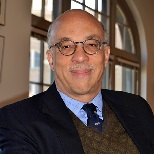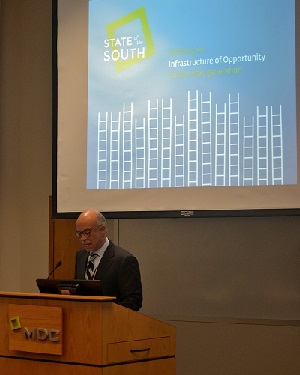As the Philanthropy Journal begins a new cycle on our editorial calendar, we will periodically republish articles from our archive. Please enjoy this piece on MDC from January 2016.
By Sandra Cyr
Many of the challenges nonprofit organizations set out to address cannot be solved in a single grant cycle. Some require an ongoing focus because they are impervious to incremental action. For nearly 50 years, MDC has been trying to solve the great challenge of creating a more equitable society in the South by helping community leaders see the inequities and adapt their focus and their institutions to the long-term work of addressing those challenges. For that work to continue requires far-sightedness—and resilience within people, and within communities. “I think the legacy of our work is people and institutions that are enduring,” says MDC President David Dodson. “You can create resilience, and I think that is a lot of what we are doing. MDC builds and strengthens infrastructure, and builds and strengthens leaders so that they can be resilient.”
 MDC, formerly Manpower Development Corp., was formed in 1967 out of Gov. Terry Sanford’s North Carolina Fund to address the changing employment landscape in the state as workers transitioned from an agricultural to an industrial economy and from a segregated to an integrated workforce. Since then, its name has changed and the focus has broadened, but MDC’s philosophy of creating an infrastructure of opportunity in the South has remained the same. So has its belief that creating a skilled workforce is the key to both economic mobility for families and economic development for the entire community.
MDC, formerly Manpower Development Corp., was formed in 1967 out of Gov. Terry Sanford’s North Carolina Fund to address the changing employment landscape in the state as workers transitioned from an agricultural to an industrial economy and from a segregated to an integrated workforce. Since then, its name has changed and the focus has broadened, but MDC’s philosophy of creating an infrastructure of opportunity in the South has remained the same. So has its belief that creating a skilled workforce is the key to both economic mobility for families and economic development for the entire community.
While MDC may be addressing some of the same problems it was addressing 50 years ago, its philosophy and practice have gotten more sophisticated. In the beginning, the focus was mainly on providing soft skills training and job training. Today it is much more about engaging leaders in understanding disparities in their communities, and seeing how people and institutions can create the right solutions for their hometowns. MDC believes that solutions must cross traditional boundaries, because the causes of inequity aren’t just deficiencies in any one area, such as education or health care or transportation—it’s all of them. That’s why MDC, in working with leaders from the grassroots to chambers of commerce to City Hall, helps them look at their community’s entire infrastructure of opportunity while specializing in programs to improve education, workforce development, and families’ economic security.
By framing the equity agenda in such a way that shows strategies that will help the South eliminate gaps in opportunities and create well-being for the people and places left behind, people can see where these gaps are in their communities, as well as the solutions that need to be developed to alleviate them. MDC has distilled this big picture approach down to a process of framing the agenda, organizing leaders, demonstrating evidence-based solutions, and scaling what works.
Through the research it conducts, MDC identifies equity and opportunity gaps. MDC’s State of the South reports, published biennially, highlight areas of inequity throughout the region. These reports are used to raise the consciousness of the leaders and the people in the communities on how important the issues raised are for all of them. They help communities see where they have been, what their situation is now, what they need to fix, and how they can do that through identifying and aligning community systems, including people and institutions. Often times, many of the pieces are there. What MDC does is find ways to put them together to address the needs of the community.
MDC’s success in part is due to the way in which it identifies with the region it serves. As one of a very few remaining organizations focused on the South, it is intimately connected to these communities. “We live here and the place we live has to be a lot better,” says Dodson. “We have had times of great growth and times of scarcity, but I think the people who are in this organization really love the place we work and care about and are committed to finding ways to make it better.”
In order to chip away at the monumental challenges these communities face, MDC builds relationships and nurtures buy-in. This process can take a long time, but when it does work, it creates a sense of collective investment in a solution. This insistence that the communities own the work is essential to the success of programs, for they will be the ones continuing the work long after MDC has left—though, often, the relationship will continue.
Adaptability has been the key to MDC’s survival for nearly 50 years. By creating resilience in people and communities, MDC has itself become resilient. As it works to address these grand challenges, it recognizes that there are still key areas in which people are being held back. Identifying what these are, and growing programs out of the lessons that have preceded them, has allowed MDC to continue to evolve.
While the scope of the work that MDC does is vast, ultimately what it does is identify people and communities in need, and then align resources and infrastructure in order for the people and communities to be successful. In working with leadership, infrastructure and institutions, MDC is making permanent change in institutions or systems that will continue long after they are gone. “That’s what we are trying to do,” says Richard Hart, MDC’s Communication Director. “We redress the problems of the past and change the system so they don’t happen again. It takes a long time to do, but you’ve got to stick with it. This is very much a long game.”
David Dodson is President of MDC. Since joining MDC in 1987, David has directed major projects to increase student success in public schools and community colleges, address regional economic decline, strengthen community philanthropy, and build multiracial leadership across the South and the nation. MDC, headquartered in Durham, N.C., has been publishing research and developing programs focused on expanding opportunity, reducing poverty, and addressing structural inequities for nearly 50 years. MDC puts analysis into action to change outcomes for people and places left behind by: framing the equity agenda to elevate strategies that will help the South eliminate gaps in opportunity; organizing leaders to act; demonstrating powerful, evidence-based approaches and solutions; and scaling and sustaining what works.
Sandy Cyr is the Managing Editor for the Philanthropy Journal, and a fan of all things related to the nonprofit sector.






